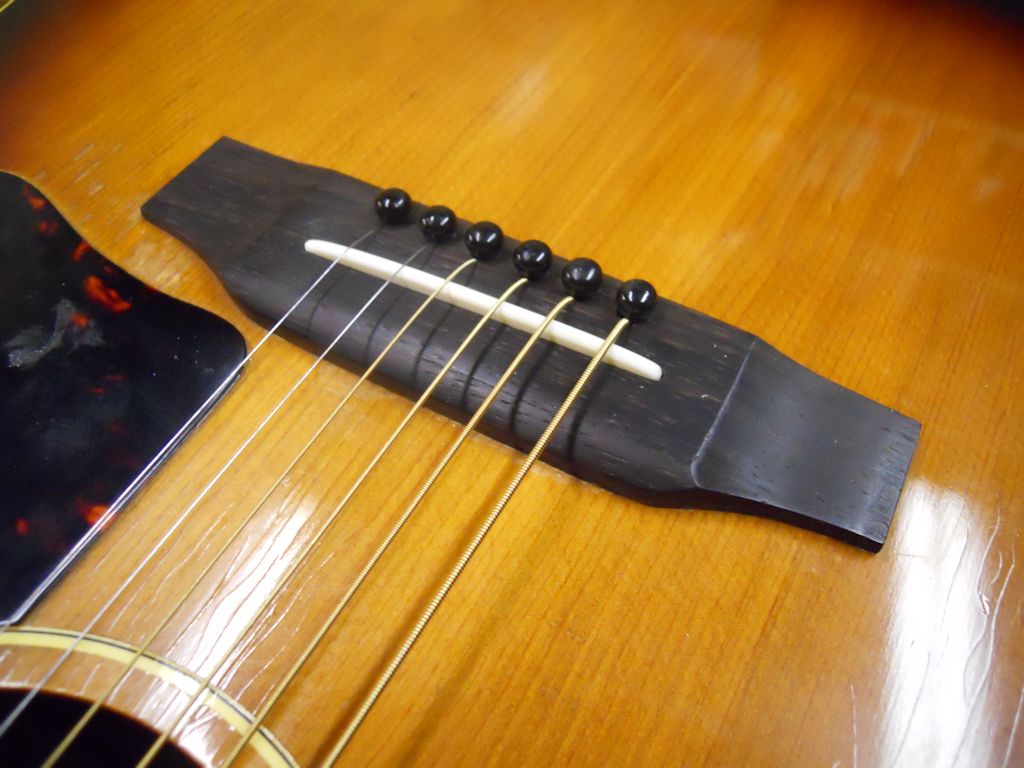|
| Repair Articles |
|---|
| Ask The Repairman |
| Repair Blue Book |
| Hardware Parts Accessories |
| Electronics |
| Guitar Wood and Kits |
| Tools |
| Friends |
|
|
|
|
|
Vintage Gibson Plastic Bridge ReplacementBy Steve Carmody c. 2017For reasons that are not entirely clear, the Gibson guitar company used molded plastic bridges on many of their acoustic guitars produced for a few years beginning in 1963. In this same era they also used plastic bridge saddles on their electric guitars, so maybe it was considered a technical innovation that they thought would stick (and, presumably, save money).These bridges were attached to the top with four screws inserted through the underside of the top. Though the use of a plastic bridge seems odd for a number of reasons, many folks enjoyed the sound of these guitars. To be sure, they did have a different, distinctive tone.
Unfortunately, very few of these bridges have survived through the years and most of them warp, or one, or all of the screw seats eventually break (note the screw seat on the right in the above picture). Since these plastic bridges are no longer produced there are no direct replacement parts. As a result, there are two standard options when trying to repair guitars which have issues with these bridges - Replace them with a plastic bridge that did not warp or break, which has been salvaged from another Gibson guitar from this era, (very few that are still in good shape are available, but they can occasionally be found). Or fabricate and install a hand-made reproduction bridge made of ebony or rosewood. Interestingly, there are factory-made wooden Gibson-style bridges produced to address the need for replacements (pictured below), but in my experience they are, ironically, not suitable replacements. They look similar, having the reverse-belly shape that Gibson used, but the saddle slot is not oriented such that the bridge will retrofit directly to the location of the original bridge. The issue is that when they are positioned so that the saddle slot is oriented for correct intonation, the string holes in the bridge do not line up with the pre-existing string holes in the top. In theory, these bridges could be used, but you have to fill the original string holes in the top and drill new holes slightly further back. For this reason, in the interest of not deviating too far from the original structural parameters, I prefer to fabricate my own wooden replacement bridges that fit as closely as possible to the original location.
A note about styling - In general, when fabricating replacement parts the goal is to make a copy which hews as closely as possible to the part being replaced.The molded plastic bridges are similar to, but not exactly contoured as, the wooden bridges that Gibson produced both before and after the plastic bridge era. In particular, the transition on the plastic bridges between the main body of the bridge and the wings tends to be softer, more rounded. Generally, the wooden reverse-belly bridges that Gibson has made over the years have a more defined transition between the body and wings of the bridge, and to my eye are more visually appealing than the softer contoured plastic style. Speaking personally here, the sharper lines just seem more intentional, less haphazard. As a result, I prefer to model my wooden reproduction bridges on the standard vintage Gibson wooden bridge styling.
Another consideration is wood choice. The molded plastic bridges are black in color, presumably to suggest an ebony bridge, and some luthiers use this as a cue to make an ebony replacement bridge. Indeed, I have done this in the past. But over time I have come to the position that using rosewood, ideally Brazilian, if available, so as to match the wood Gibson used for fretboards on these guitars, is preferable. I would also note that, traditionally, luthiers match the wood of the bridge to that which is used on the fretboard. So a guitar which has a rosewood fretboard, as this one does, would usually have a rosewood bridge. Rosewood is also a logical choice in this case since it is lighter in weight than ebony (which would be much heavier than the original plastic bridges) and seems to have less of a damping effect on the guitar. Since the original plastic bridges, held on with 4 crews, imparted no added stiffness and next to no added weight to the top, the lighter wood is also a plus in this regard.
The general process of fabrication is the same as with the reproduction of Martin bridges as described in my article on that subject - Acoustic Guitar Bridge Fabrication - so I will not repeat the procedures here, but in creating this bridge, obviously, I am focusing on reproducing the details of Gibson styling. Here is the finished reproduction Gibson reverse-belly wooden bridge installed on a 1963 LG-1.
Copyright Steve Carmody 2017 - Steve Carmody is an independant guitar repairman and luthier with a shop in Silver Spring, Md. He has been doing guitar repair and restoration full-time since 1990. Questions about this article or anything else related to guitar repair? Send e-mail to - GuitarRepairShop@aol.com |



